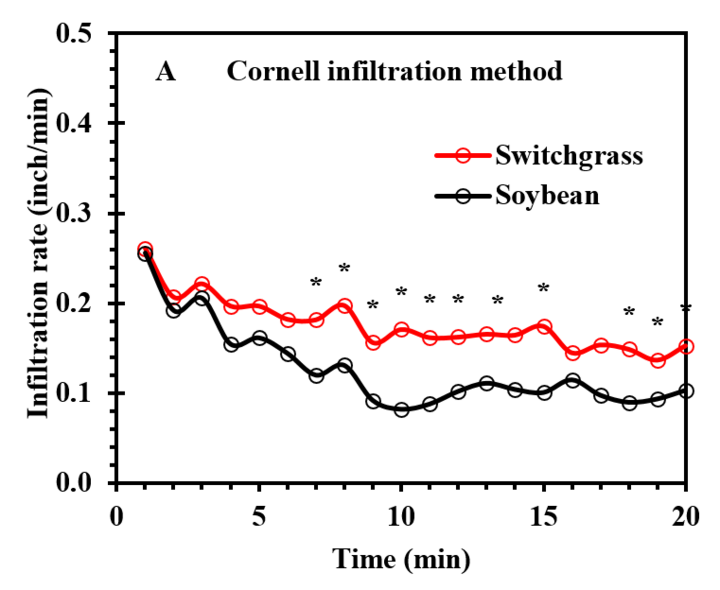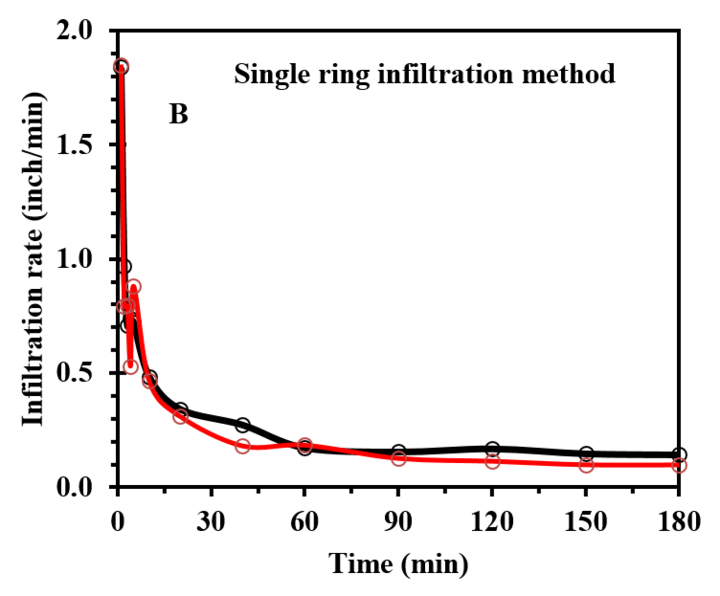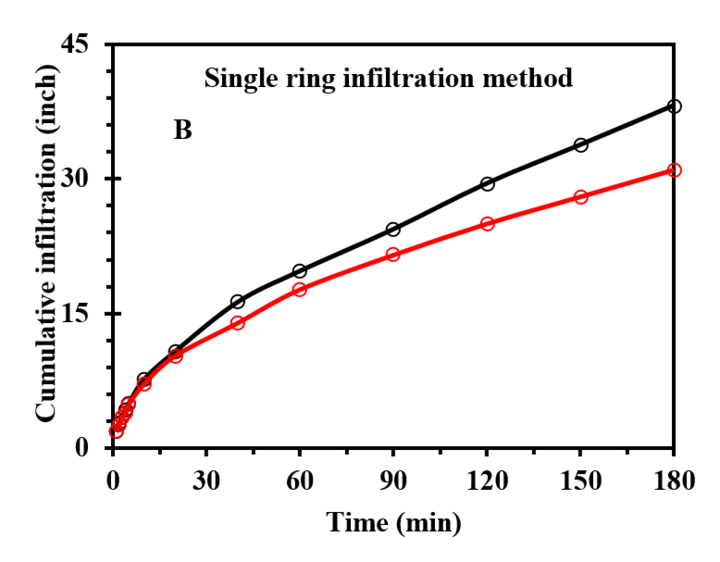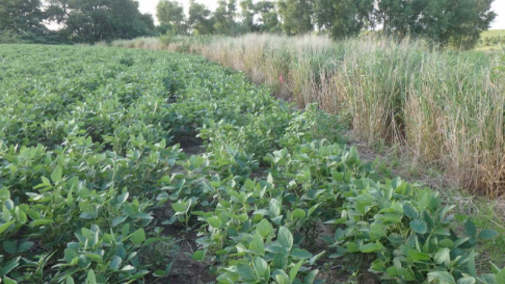Grace Kurtz, Student at Seattle University and 2017 University of Nebraska-Lincoln Integrated Agronomic Systems Intern
Humberto Blanco, Soils Specialist, Department of Agronomy and Horticulture
Manbir Rakkar, Doctoral Student, Department of Agronomy and Horticulture
John Guretzky, Forage Specialist, Department of Agronomy and Horticulture
Dean Eisenhauer, Engineer, Department of Biological Systems Engineering
Tom Franti, Engineer, Department of Biological Systems Engineering

What are Grass Barriers?
Grass barriers are parallel strips of perennial grasses established on the contour within croplands (Figure 1). Warm-season grasses such as switchgrass can be effectively used as grass barriers. They are of interest to farmers because they can be an alternative to terraces to manage and conserve soil and water.
How Do Grass Barriers Conserve Soil and Water?

These barriers are strips of dense, stiff-stemmed grasses established perpendicular to the direction of the field slope. Ideally, when it rains, water not absorbed by the row cropland area enters the grass strips. The dense grass acts as a barrier to obstruct runoff. Runoff velocity is reduced and water containing sediment ponds above and within grass barriers. The ponded runoff gets an opportunity to infiltrate into the soil (Figure 2). In addition to the aboveground biomass acting as a physical barrier to runoff, grass barriers can conserve soil and water by improving soil properties. Accumulation of litter and development of extensive root systems under perennial grass combined with lack of soil disturbance can increase soil organic carbon concentration, improve soil structural properties, and increase water infiltration, among other benefits.
What Have Researchers Found Regarding Switchgrass Barriers and Soil Water Conservation?
In July 2017 we compared water infiltration in switchgrass barriers in no-till and conventionally tilled cropland in an existing experiment at the university's Rogers Memorial Farm, about 10 miles east of Lincoln. The four-foot wide switchgrass barriers were established in 1998 in parallel rows (at 40-yard intervals) in a soybean-sorghum-corn rotation. Water infiltration was measured with single ring infiltrometer and Cornell infiltrometer methods during the soybean phase. Additional details on the existing experiment are described by Blanco-Canqui et al. (2014).


We did not observe any difference between water infiltration of conventional and no-till systems. Therefore, data was averaged across tillage systems to compare water infiltration between soybean and switchgrass barriers. Results from the Cornell infiltrometer method showed switchgrass barriers had a significant increase (30%) in infiltration rate compared to soybean (Figure 3). The barriers had different cumulative infiltration amounts measured by the Cornell infiltrometer and the single ring infiltrometer, but these differences were not significant (Figure 4). These results suggest that grass barriers can increase the water infiltration rate. Studies, such as those by Rachman and colleagues in southwest Iowa, also have shown that switchgrass barriers generally have higher infiltration rates when compared to cropland (Rahman et al., 2004).


The observed increase in infiltration rate under switchgrass barriers could be due to improvement in other soil properties. For the same experiment, Blanco-Canqui et al. (2014) reported that switchgrass barriers annually accumulated 0.38 ton per acre more soil organic carbon than cropland areas. An increase in soil organic carbon concentration improves soil structure by creating and stabilizing macroaggregates. The stable macroaggregates favor macropore formation and improve the connectivity of soil pores. Concurrently, up to a 4% increase in total porosity was observed in grass barriers compared to cropland areas. This improvement in soil structural properties can explain the increased water infiltration under switchgrass barriers.

Although differences in cumulative water infiltration were small, grass barriers yielded less sediment in runoff compared to cropland (Figure 5), indicating switchgrass barriers can reduce sediment loss from croplands. The ability of switchgrass barriers to manage sediment loss can help to improve water and soil quality. Runoff containing sediment from cropland is one of the largest sources of water pollution. Switchgrass barriers can mitigate such water pollution by filtering and trapping sediment.
As reported by Blanco and colleagues, switchgrass barriers also reduce water pollution by intercepting nitrogen and phosphorus that flow off cropland. Furthermore, switchgrass barriers annually accumulated 0.04 ton/acre more total nitrogen than the cropped area. The observed increase in nutrients such as nitrogen also can be due to increased soil organic carbon. Soil organic carbon can bind and retain nutrient ions. Overall, retention of more nutrients in soils under grass barriers can help mitigate water pollution while maintaining soil fertility.
Looking Forward
In summary, switchgrass barriers can increase the water infiltration rate in soils by improving soil structure, soil organic carbon concentration, and porosity. The reported decrease in sediment loss in grass barriers suggests that switchgrass barriers can reduce soil erosion in croplands.
The use of switchgrass barriers along with other conservation agriculture practices such as no-till, can minimize soil erosion on sloping land (Borrelli et al., 2017). Consequently, less sediment loss from croplands will maintain soil fertility and reduce water pollution. Further research need to evaluate how switchgrass barriers perform under varying slope and soil types. Overall, switchgrass barriers can be one of the strategies to conserve soil and water in sloping fields.
References
Borrelli, P., D. Robinson et al. 2017. An assessment of the global impact of 21st century land use change on soil erosion. Nature Communications. doi:10.1038/s41467-017-02142-7.
Blanco-Canqui, H., C.J. Gantzer, S.H. Anderson, and E.E. Alberts. 2004. Grass barriers for reduced concentrated flow induced soil and nutrient loss. Soil Science Society of America Journal. 68:1963-1972.
Blanco-Canqui. H., J. Gilley, D. Eisenhauer, and A. Boldt. 2014. Soil carbon accumulation under switchgrass barriers. Agronomy Journal. 106:2185-2192
Rachman, A., S.H. Anderson, C.J. Gantzer, and E.E. Alberts. 2004. Soil hydraulic properties influenced by stiff-stemmed grass hedge systems. Soil Science Society of America Journal. 68:1386–1393.

About the Lead Author
Grace Kurtz is one of seven undergraduate students completing an Integrated Agronomic Systems Fellowship at the University of Nebraska-Lincoln in summer 2017. She returned to Seattle University with a strong appreciation for soil to complete a degree in civil engineering.
Support
Support for this project was provided by the USDA NIFA Agriculture and Food Research Initiative: Education and Literacy Initiative–Undergraduate Experiential Learning Fellowship Program and the University of Nebraska-Lincoln Department of Agronomy and Horticulture.

